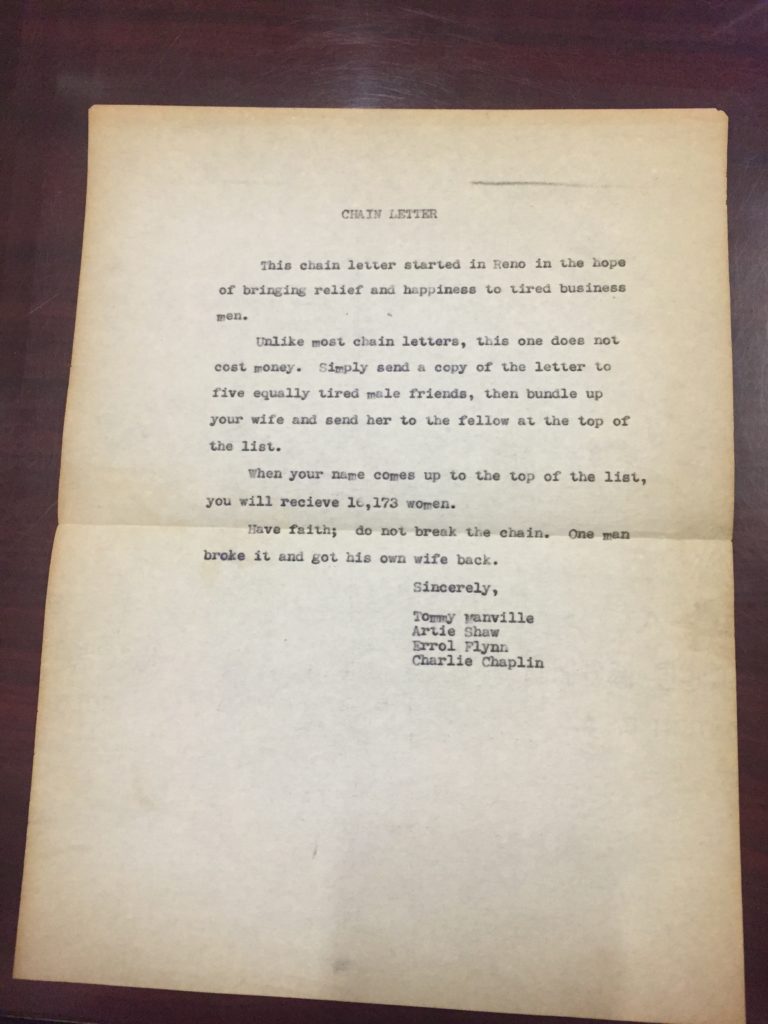Send this to 20 friends and the Lighthouse will get a pony for every share…
We have all gotten those emails asking us to “continue the chain.”
Written inside is a funny story that, if shared, will bring you luck, love, or money. However, if you break the chain you will be met with opposite results. You might lose a shoe or your crush will never speak to you again. Though for the vast majority of us we take a look and then delete or depending on how funny it was we may send it to the next group. It has become a silly superstition that we share to brighten someone’s day. Though a century ago this was not the case.
In the summer of 1888, a school in Chicago decided to send out letters asking for support. The recipient of the letter was to send them a dime. That same person was then asked to make three copies of the letter and send those letters to their friends. Those friends send it to their three friends who then share it with their three friends before you know it; it has gone from three people to 273 people.
At the time, the population in Chicago was a little over one million. If each resident of Chicago sent in a dime the school would have $100,000. Similar campaigns were used to fund a memorial for the veterans of the Spanish-American War and a bike trail in Michigan, just to name a few. They came to be known as “Send a Dime” campaigns. While they did not make the original sender piles of money it did provide the world with a new marketing ploy.
As these letters started to veer away from money and focus on jokes and superstitions one such letter emerged. The exact date of the letter is unknown, however in 1947, several newspapers printed the letter because it was a chain letter of an entirely different kind.
A copy of this letter, signed by Tommy Manville, Artie Shaw, Errol Flynn, and Charlie Chaplin, is currently in our collection. The dark humored joke gained fame as it promised the recipient over sixteen thousand women. That is, provided that he sent a copy letter to five “tired” male friends. He was also instructed to “bundle up his wife and send her to the man whose name was on the top of the list.”

It warned against breaking the chain, chiding that one man broke it and got his own wife back. As more and more people started to create and share their own letters it became increasingly difficult for the United States Postal Service.
The influx of letters overwhelmed several post offices. In 1904, one post office in Denver was forced to shut down for three days and hire 13 extra postmen to sort mail. Similar situations happened throughout the nation causing the USPS to change a portion of their operating code.
Today, under Title 18 Section 1302 of the Postal Lottery Statute, chain letters that revolve around a financial gain are considered gambling. It is unlawful to gamble through the mail. The USPS also warns that while you may be a trusting soul not everyone will be, so do not be fooled by the promise of wealth.
While “Send a Dime” campaigns turned out to be a dud as far as getting rich quick, this letter shares a story of transition. Our postal service transitioned into facilities that could handle higher capacities of a growing nation. Advertisers and media learned a new way to get our attention and have us do some of the work for them.
All in all, we may roll our eyes at the chain letter that promises a wish if we share with 12 friends, but they are a semi-useful tool that has been around a lot longer than we thought!
Barb Holland joined the St. Augustine Lighthouse & Maritime Museum family in 2012 and currently works as the Collections Manager. She has a bachelor’s degree in history from Aquinas College in Grand Rapids, Michigan.


